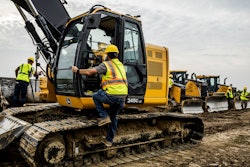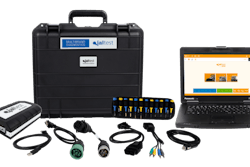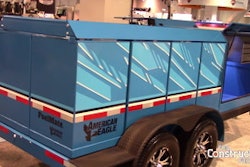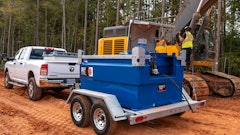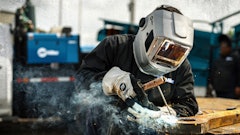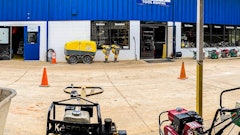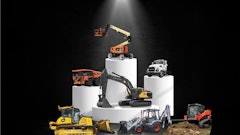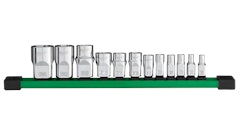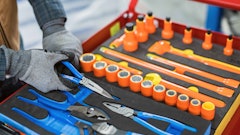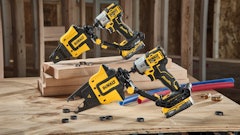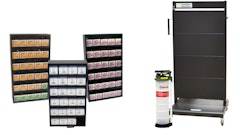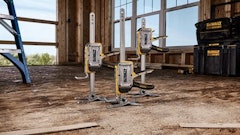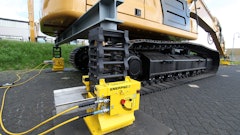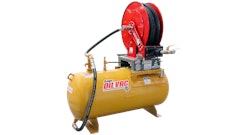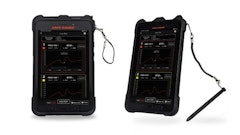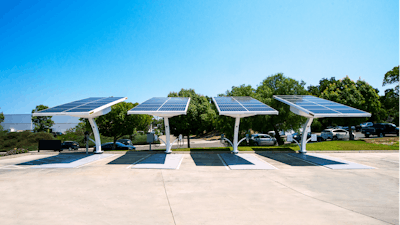
The asphalt industry is transitioning towards electric equipment as many companies such as LeeBoy, WIRTGEN Group (including its Hamm subsidiary), Volvo CE, BOMAG, Ammann, and Dynapac have rolled out equipment used in asphalt paving with much of it offering a full day’s work on one charge. Other companies are actively exploring electric options.
Fueling trailers in the field are becoming increasingly available in the market to provide charges to electrical equipment on a jobsite.
Federal, state, and local incentives are a part of the driving factor toward EV equipment adoption.
“The grid is very fragile, especially with the increase in natural disaster activities,” points out Keith Marett, CEO of Portable Electric. “This is where solutions like Portable Electric really fit in as well as just general use around construction sites.”
Marett notes his company’s mission, “is to remove the need for carbon based fuels at industrial sites, whether that be the power generation to power tools or whether that is inside the equipment itself they are using at the site. Our goal is to eventually migrate away from the use of those carbon-based fuels.”
In 2015, Portable Electric started making what it classifies as an e-Generator.
“This is a battery-based generator solution that allows us to produce in varying sizes AC power for all jobsite activities,” he says. “At the same time, we have combined it to have DC charging capabilities. You can power your tools and you can fast charge your electrified equipment.”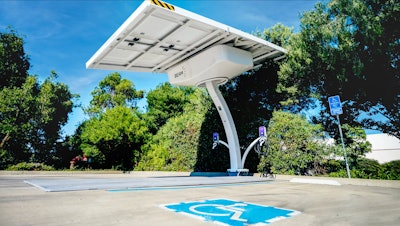
The company offers two portable generators and three mobile units that provide various levels of kWh capacity and output, peak power, charge time and lifecycle.
The portable series includes the Voltstack 5k e-Generator and the 5k L2 e-Charger. The company’s mobile units include a 30k e-Generator, a 30k L2 e-Charger, and a 30k L3 e-Charger.
The Voltstack 30k features ‘Smart Hybrid’ technology which seamlessly integrates a diesel generator to provide off-grid power when the battery reaches a low charge state.
The Voltstack ecosystem of portable electric generators and mobile hybrid energy systems can be recharged via the Portable Electric Sunstack folding solar kit.
Integrating the Voltstack 5k with the company’s NeuronOS software enables users to track, analyze, and optimize energy consumption in real-time.
A three-inch touchscreen display enables users to check critical alerts and monitor the Voltstack 5k’s charge status.
The generators are powered by grid power.
“You can bring our unit up to site and leave it for a few days depending on the power needs of that site,” Marett points out. “Then you would bring it back to your warehouse, charge it up overnight, and bring it back to the job site the next morning.
“If you are truly remote and you do not have the ability to come back to the grid or facility, you can hook up a small gas generator or diesel generator to just purely charge up our unit. You are not running that generator all day. You are just running it for a period of time to charge up our unit, and then it would shut down.”
Because the charging solutions are coupled within a single unit, contractors do not have to invest in onsite charging infrastructure at their sites, Marett notes, adding that it aligns with construction companies’ goals to save costs.
“Another benefit is there’s no fuel handling, so you don't have to have the diesel certification tickets in order to handle our equipment,” Marett points out. “Anybody can operate it. Everything is touch safe. There is no special skill or technician required.”
Marett says the fact that the company’s trailer solutions can be towed behind any class vehicle provides the benefit of not requiring a CDL or special license.
“It’s quite easily transportable as a power source,” he adds. “It works in lots of different scenarios. You might be off the grid quite a bit and it allows for that. We also do a lot of urban applications where there might be grid power at the site, but it might not be specifically where you are working at that site. It is basically a grid extension cord.”
To add to off-grid electric equipment charging, Volvo Construction Equipment and Portable Electric recently introduced the PU130. Designed, engineered, and built by Portable Electric, the unit enables rapid recharging of electrified construction equipment aimed at significantly reducing downtime and increasing jobsite productivity.
With Portable Electric’s 48-Volt Direct Current Fast Charging (DCFC) technology integrated, the PU130 is designed to offer construction sites the ability to rapidly recharge equipment – such as during a lunch break – to service a full workday and beyond.
In addition to recharging electrified construction equipment at a 20 kW charge rate, the PU130 can simultaneously provide 40 kW of jobsite power to support tools, lighting, and office trailers. It has a storage capacity of 130 kWh.
The PU130 is designed to seamlessly hybridize with other power generation systems for extended power to ensure continuous operation with minimal environmental impact.
As with all Portable Electric power and charging solutions, the PU130 is designed to offer seamless connectivity with Neuron OS for remote monitoring through real-time data, analytics, and GPS tracking to optimize charging schedules and ensure maximum efficiency.
Ray Gallant, Volvo Construction Equipment vice president, notes that adding the PU130 to Volvo's product offerings, “represents a significant milestone in our journey towards sustainable construction practices.”
Portable EV charging units are either purchased by contractors for in-house use or rented through such companies as Sunbelt Rentals.
Marett says many companies opt to go through rental companies to source units.
While the electrification of construction equipment is on an upward path, there continues to be options such as the diesel fuel transport trailers offered by companies such as Fuel PRO.
“We build them with an electric pump and with gas engine pumps,” says Nathan Frey, owner. “I always thought there may be a day we build something like an electric charging system for a trailer but we haven't had a request for it.”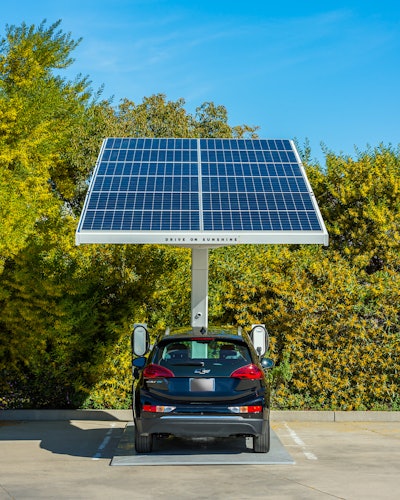
Throughout time, humans have adopted new technologies that create more efficiencies in work and life. Initially, they may not be cost effective, but eventually the trajectory of all electronic technologies – such as laptops, for example – become less expensive over time.
“We know a lot about the benefits of electrification,” Marett notes. “Besides the ESG (environmental, social and governance) or ‘feel good’ side of it, there is obviously the reduction in greenhouse gases.
“A lot of electrified equipment has better efficiencies and can get better productivity than what the diesel equivalent vehicles can. Same thing with our generators – the fact that there is no need for down time to replace the filters and oil, you get higher productivity.”
That does come at a premium, Marett adds.
“Our products are a premium over the diesel equivalent,” he says. “It will come down progressively over time. A computer that costed thousands years ago now costs hundreds. That is the same thing with these solutions over time. Electric vehicles are going to get less expensive regardless of what is happening at the government side in terms of incentives.”
Marett advises contractors to make sure their teams understand the new EV technology, its benefits and are trained on it “before there might be government mandates that come down and say that you have to adopt it in a short time period.”
Marett notes the health benefits of EV equipment to workers.
“There’s definitely the benefit of no emissions,” he says. “The other benefit from a health perspective that relates to productivity is no noise. Our units are completely silent, so you do not have to worry about any hearing damage.
“You do not have to wear ear muffs. You can communicate to the person right next to the equipment without having to yell or stop the electrified paver. Someone standing next to our equipment can literally talk at a normal voice level versus having to stop the job site to communicate.”
Marett says the biggest challenge he sees is that while contractors understand the benefits of having EV equipment, they have concerns about the time it takes to recharge it in the field, let alone finding grid access in doing so.
“At a job site, they want to make sure you've got the power there to charge the electrified paver or whatever they're working with,’ he says. “You do not want to be down for hours on end while you are waiting for the unit to recharge.
“That is where our solution offers the ability to do a 20-minute quick charge. It can be done over lunchtime to get the work back up and running in a very high productivity way.”
Desmond Wheatley, Beam Global president and CEO, notes that while full electrification of transportation is starting with sedans and lighter duty vehicles, BEAM has already deployed its products for construction equipment.
“There are lots of markets where construction equipment is increasingly coming under regulations which are designed to minimize their particulate matters and other exhaust fumes, noise pollution in already built-up environments,” he notes.
As such, Wheatley predicts prices on EV technology – including construction equipment – will start to come down dramatically.
Wheatley notes on new build projects, electricity is often one of the last components to be brought into the site.
“If you’re laying asphalt down on roads, highways and parking lots, there's not a ready supply of electricity at scale that's required to recharge these types of vehicles,” he points out.
BEAM solves for that by delivering products to the site which generate and store their own electricity.
The EV ARC 2020 system is designed to generate and store its own electricity by tracking the sun to generate up to 25 percent more energy.
Battery storage allows users to charge during the night, inclement weather, and power outages.
It is designed to fit inside a standard parking space.
“We don't have to rely on a grid connection,” Wheatley says. “We do not have to connect to existing wiring or extend the utility grid to those locations in order to be able to charge. We are able to drop off a product which generates and stores electricity, and then delivers that to those pieces of equipment.
“What we find with the construction equipment we have already energized is looking at the way they typically duty cycle. People take breaks or the equipment is used for a while and then it is not used for a while.”
That means the equipment can be periodically charged during the course of the day instead of running it until it is empty and then trying to recharge it all the way, Wheatley notes.
One does not need a special license to transport the EV ARC 2020. The ARC Mobility Trailer can be used to tow the unit to the jobsite.
“If you have the skill set to tow a boat, then you can deploy one of these units,” Wheatley says.
The specialized hydraulic transport solution uses remote controlled hydraulics enabling one person to stow, transport, place, and unstow.
The EV ARC 2020 does not need a prepared surface, Wheatley notes.
While it essentially needs a flat surface, it can be deployed on grass, gravel, and sand. Although it weighs 10,000 pounds, its weight is dispersed.
The EV ARC 2020 is typically a purchased product, but BEAM also does leasing programs.
With the trailer, users can deploy the units to where it is needed, “which is perfect for construction because they finish one area of a project and they just pick it up and take to the next project,” Wheatley says.
For those concerned about weather-related challenges in using a portable EV charging station, Wheatley notes that the unit is rated independently to withstand 160 mile-an-hour winds.
“The product is designed to operate in a broad range of environments. They have withstood 185 mile-an-hour Category 5 winds in the Caribbean where we are deployed,” he adds. “It’s flood-proof to 9.5 feet.”
Wheatley notes the biggest challenge where weather is concerned is “actually not going to come from those types of harsh conditions because we survived them really well. It is a very robust product made here in the United States.
“The biggest issue is we are relying on light to make electricity. It does not have to be direct sunlight. But if you are in very cloudy, prolonged conditions you are going to generate less electricity than you do in situations where you have got a good sunlight resource. That is something that needs to be taken into consideration.”
There often are concerns with EV-related hardware that there is a lack of people trained to fix problems. Marett notes that with the company’s mobile power solutions, there is little maintenance as there are no mechanical parts prone to wear or tear failures.
“Every single one of our devices are connected to the cellular network,” he says. “We get diagnostic data in real time back from our units, and our customers have a dashboard so they can see immediately what the state of charge of the system is, the duration of the battery, how long it's going to last before it needs to be recharged, if there are any fault codes or issues that they need to be aware of.”
That alerts Portable Electric to situations that need to be fixed.
“Our solutions are complex in nature,” Marett notes. “If there is an issue or an alert, we either try to fix it over the air through our software and if we cannot do that, then we send one of our technicians to the field. Throughout North America, we have the ability to be at a location effectively within the next day.”
Addressing those concerns about having knowledgeable mechanics to fix any issues, Wheatley says the EV ARC 2020 has very few moving parts.
“We also get live telemetry from the units – we’re able to see the state of health and manipulate them remotely,” he adds. “They all connect either to a cellular network, or if there is no cellular, then we can use satellite. Just like your laptop, we can reboot them remotely. If it requires a visit, then we are sending somebody from our service team.”
Wheatley notes that like most new technologies, “there will be some hiccups as we roll through it but it's going to be tremendously beneficial to the industry in terms of reducing their costs, increasing their uptime, and making sure the operators are a lot more comfortable running these things (such as noise reduction).”
For those contractors who do not want to invest in an EV fueling trailer, the units can be rented.
For example, Sunbelt Rentals offers a variety of portable and stationary EV charging stations for rent, including DC fast chargers, Siemens Level 2 chargers, and AC chargers. Sunbelt Rentals also offers portable battery energy storage systems (BESS) with 5kW and 7kWh of energy. BESS units collect and store energy from the grid or a generator, and then discharge it later to provide a reliable source of electricity.





